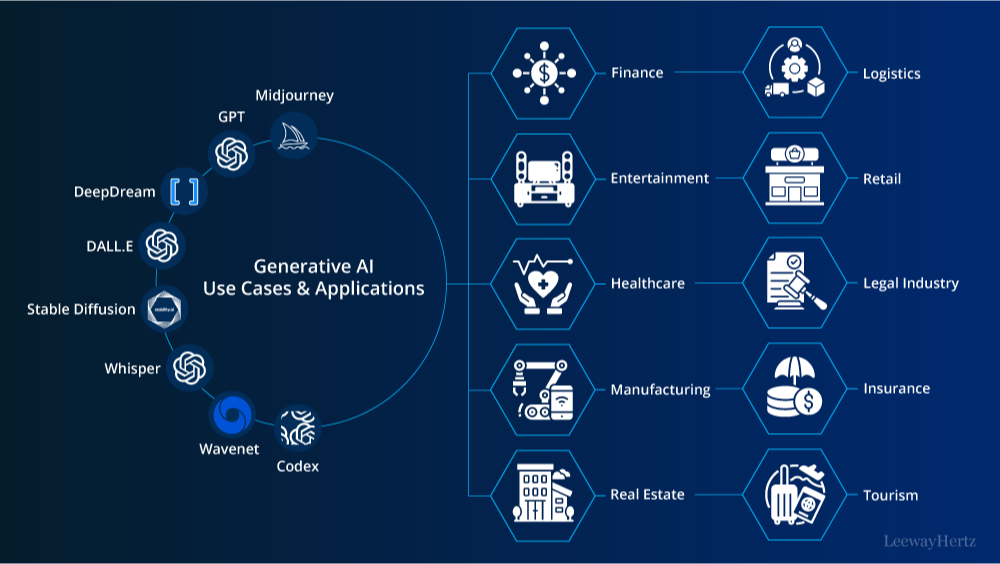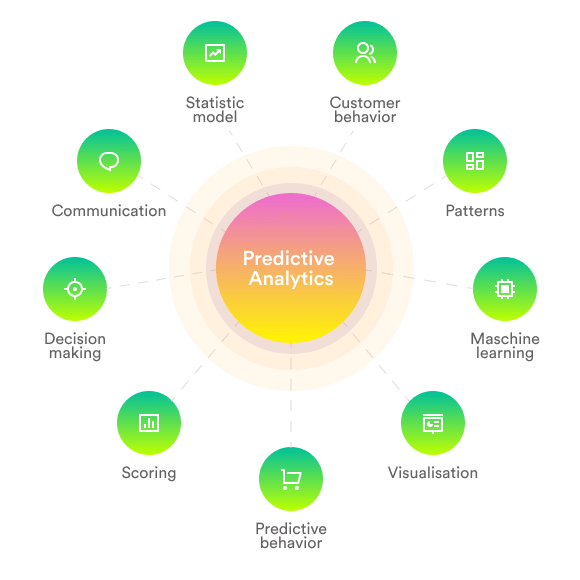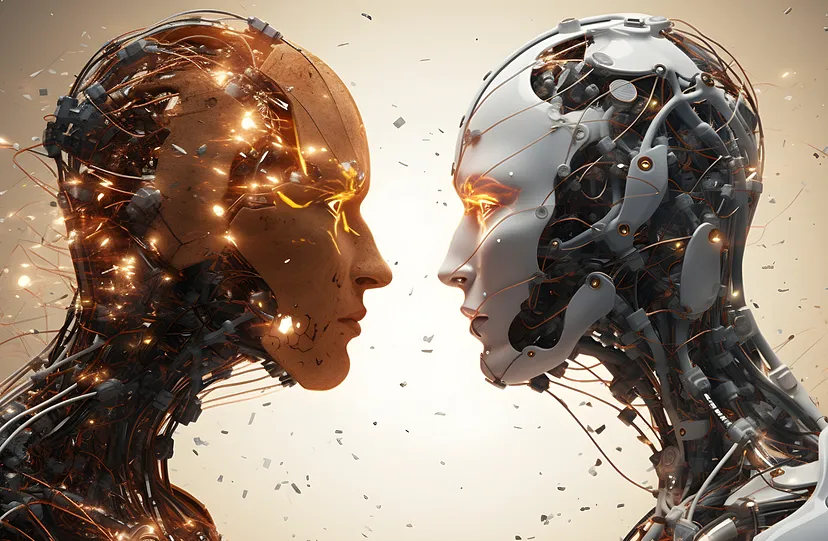Generative AI vs Predictive AI have fundamentally altered the workflows of industries in distinct ways. Tasks that would take human hours are now done in seconds. Businesses have chatbots available around the clock to help customers solve their queries. Its application is even employed in airports to guide older people on which way to go. But what makes AI driving these changes are generative AI and predictive AI.
Generative AI is designed to generate original ideas. It focuses on creating unique text, music, and graphic material. It can also design clothing, create symphonic works, and write poetry inspired by nature.
Predictive AI, on the other hand, assists in making predictions about future trends and patterns. It uses historical data analysis for that goal, and weather forecasting is one major area in which it is applied. This blog will cover the purpose and applications of generative AI vs predictive AI.
Comparison Between Generative AI vs Predictive AI
| Feature | Generative AI | Predictive AI |
|---|---|---|
| Focus | Creates entirely new and original content | Analyzes data to forecast future events or outcomes |
| Techniques | Machine learning algorithms, Generative Adversarial Networks (GANs), Transformers | Machine learning algorithms, statistical modeling |
| Data Dependence | Heavily reliant on the quality and quantity of data used for training | Relies on historical and current data to identify patterns |
| Applications | Creative arts (text, image, music generation), content creation, product design, drug discovery | Business analytics, finance (fraud detection, stock market trends), healthcare (disease prediction, personalized medicine), customer |
| Outputs | New creative content (poems, paintings, music), data augmentation | Predictions about future events (customer churn, equipment failure), insights into trends and patterns |
| Creativity | Can generate novel and impressive content but lacks true human-like creativity. | Doesn’t possess creativity, but can identify patterns and relationships that humans might miss. |
| Explainability | Can be challenging to understand how generative AI arrives at its outputs | Models can be complex, but explainable AI techniques are being developed to improve transparency |
As elaborated earlier, the various applications of Generative AI vs Predictive AI are significant across industries and creative domains, each offering distinct benefits.
Generative AI is strong in creating original and fresh content. It can be an effective tool for generating ideas and exploring creativity but it shouldn’t be considered a substitute for human creativity. Predictive AI is an effective tool for data-driven decision-making. Still, the completeness and quality of the data used to train the models determines how accurate the forecasts will be. Some distinctions between the two are listed below.
What Is Generative AI?
It is a subset of artificial intelligence that uses machine learning algorithms to learn patterns and features from existing data to produce new, unique content, such as text, images, audio, and videos.
Generative AI uses various methods, such as generative adversarial networks (GANs), autoencoders, and variational autoencoders (VAEs), among its primary features. It’s not dependent on pre-programmed rules or precise instructions. Instead, it learns independently and generates new information according to how well it comprehends the data.
It excels in artistic pursuits such as painting, designing, and music creation, offering unprecedented creative potential. Its unique capability to generate original content distinguishes it from previous AI iterations. Its versatility spans various industries, including product design, healthcare, finance, entertainment, sales, marketing, and software development.
Applications of Generative AI

Generative AI’s reach extends far beyond mere entertainment. It’s transforming numerous industries. Here are some exciting generative AI applications.
- Creative Arts: Generative AI has transformed the world of artists and designers. Before AI, even a single piece of creativity took months, and still, the design was not impressive, and the beat was not on point in music. But Generative AI is pushing the boundaries of creative expression. It helps to compose music that rivals the masters or generate artwork in the style of your favorite artist.
- Content Generation: Marketing is necessary for a business to represent itself. It is crucial to choose the right language and content because it presents the company’s brand and goods. Fear not—generative AI aids in the creation of excellent, economical, and captivating content for users. In a fraction of the time it takes humans to write them.
- Fashion and Design: Fashion is not complete without design. Now that designers can access generative AI tools, producing fresh, original designs is simpler. Generative AI handles designs, freeing designers to concentrate on other elements like fabric choice, production techniques, etc.
- Music Composition: Today, generative AI can compose music in a variety of genres and even generate original soundtracks for movies, television shows, and video games. It’s bringing artists new opportunities even if it’s not as emotional as music created by humans.
- Virtual Worlds and Gaming: In video games, artificial intelligence is often used to create virtual environments and characters. Beyond that, generative AI uses deep learning algorithms to create unique, original characters, environments, and storylines for video games.
- Healthcare and Drug Discovery: AI is speeding up the drug discovery process, transforming the healthcare sector. It draws knowledge from enormous datasets of chemical structures and medicinal substances to suggest innovative therapeutic formulations. For humans, it can take months or even years to thoroughly analyze and optimize pharmacological prototypes; with generative AI, this process can be completed in a matter of days or weeks.
Advantages of Generative AI
Generative AI offers many advantages that can benefit individuals and businesses. Here are some key highlights.
- Increased Productivity and Creativity: Generative AI is beneficial when it comes to automating repetitive tasks like content creation, As it is one of the most time-consuming tasks and requires dedication. But now, humans can focus on more important, creative tasks while AI takes care of the rest.
- Cost-effective: It is an affordable solution because generative AI eliminates the need for significant human labor in tasks like design and content development. By reducing errors and increasing efficiency, it also helps organizations save money.
- Enhanced Efficiency and Speed: It produces large volumes of content rapidly, boosting workflows and speeding up procedures. This proves beneficial in product creation, design, and marketing domains. By quickly evaluating large amounts of data, It allows for faster problem-solving and decision-making.
- Improved Personalization: By customizing recommendations and content to each user’s preferences, generative AI can personalize experiences. It elevates customer satisfaction and engagement levels. Additionally, it aids companies in more effectively identifying and focusing on their target market.
- Innovation and Discovery: Generative AI helps with idea generation and offers new possibilities. It can potentially produce ground-breaking discoveries in disciplines like materials science and medication development. It can also serve as an inspiration for novel approaches and styles in the creative industry.
- Breaking Creative Barriers: Generative AI helps people with creative endeavors, even without formal training, democratizing creative expression and making it more accessible. It also helps break creative barriers by generating unique content and ideas humans may not have considered.
Limitations of Generative AI
While generative AI has many advantages, it also has limitations and challenges. Here are a few to consider.
- Data Bias: Because generative AI learns from existing data, it might provide biased or incorrect results if the data has biases or faults. If not closely watched over and dealt with, this could reinforce societal problems like prejudice and discrimination.
- Lack of Emotional Depth: The emotional nuance and personal touch that people may provide to their projects may be absent from AI-generated entertainment. This is particularly clear in industries like music, where the artistic medium itself depends on the emotional impact.
- Ethical Concerns: As Generative AI develops and gains the ability to produce unique material, ownership, and copyright issues become increasingly ethical. How is content created by AI protected, and who owns the rights to it? With the increasing use of AI across multiple industries, these problems need to be addressed.
- Overreliance on Technology: Although generative AI increases productivity and efficiency, people could become overly dependent on technology. This might result in a decline in creativity and critical thinking as well as possible job losses in some industries.
- Computational Cost: Generative AI models can be computationally intensive to train and operate, which limits their usability for some users. This could make it more difficult for companies and individuals to deploy generative AI.
- Limited Reasoning Ability: Reasoning and contextual understanding are beyond the capabilities of generative AI. This results in outputs that are illogical or have a logical flow problem. To guarantee the accuracy and consistency of content produced by AI, human participation is still required.
What Is Predictive AI
Predictive AI is distinct from generative AI, which creates original ideas based on available data. Instead, predictive AI focuses on historical data to forecast future events or outcomes. It makes predictions based on that data and identifies patterns using various algorithms and machine-learning techniques. This allows for anticipatory decision-making and helps businesses plan and strategize more effectively.
Applications of Predictive AI

Predictive AI is refining numerous industries by offering powerful forecasting capabilities. Here’s a glimpse into some of its most impactful applications:
- Financial Markets and Trading: In the world of finance, making smart investment choices requires precise stock price prediction. Predictive AI examines trends in market data and finds patterns to help investors make wise decisions.
- Healthcare and Medical Diagnosis: To preserve lives in situations like cancer, early diagnosis is essential. Predictive AI determines a particular disease by analyzing medical data such as scans and patient histories. Through prompt treatment, this early detection improves patient outcomes and saves lives.
- Customer Relationship Management (CRM): For every business to generate leads, providing excellent customer service is essential. Predictive AI assists by forecasting customers’ needs, interests, and behaviors. This enables businesses to offer personalized customer service and tailored marketing initiatives.
- Supply Chain Management: Predictive AI plays a crucial role in helping organizations optimize their supply chains by precisely projecting demand and identifying possible hazards or interruptions. This reduces waste, optimizes production processes, and makes inventory management easier.
- Predictive Maintenance in Manufacturing: It also reshaped the manufacturing industry with its ability to predict potential equipment failures before they occur. This enables companies to perform maintenance and repairs proactively, reducing downtime and increasing overall efficiency.
- Risk Management and Fraud Detection: Predictive AI is widely used in risk management and fraud detection by analyzing past data and patterns to identify potential risks or fraudulent activities. This helps companies mitigate risks and prevent losses.
Advantages of Predictive AI
Predictive AI stands at the forefront of a technological revolution, reshaping industries and transforming how we approach forecasting and decision-making. Here are some of the advantages of predictive AI.
- Improved Decision Making: Predictive AI enables businesses and organizations to make more informed decisions by offering data-driven forecasts. Imagine making more confident strategic decisions leading to better results if you have dependable insight into the future market.
- Efficiency and Cost Savings: Predictive AI assists in identifying possible issues that arise. Which minimizes the cost of reactive solutions, cuts waste, and expedites operations. For example, predictive maintenance in manufacturing prevents costly equipment failures and production downtime.
- Risk Management and Mitigation: Predictive AI is very good at spotting and reducing possible hazards. Businesses are made aware of potential risks such as fraud, market downturns, or supply chain disruptions through data analysis and discovering hidden patterns. This makes it possible to take preventative action to protect operations and reduce financial losses.
- Personalized Experiences: Hyper-personalization is made possible in several sectors by predictive AI. In the context of marketing, it can anticipate consumer preferences and customize suggestions to maximize interaction. In the healthcare industry, treatment regimens can also be tailored based on unique patient data.
- Innovation and Discovery: Predictive AI can unveil obscured patterns and trends that conventional methods often fail to reveal. This breakthrough technology has made significant strides in fields such as finance, medicine, and materials science. It fosters innovation across various sectors by identifying connections between data points that might go unnoticed by humans.
- Improved Safety and Security: Predictive AI is a pivotal tool in enhancing security and safety across various scenarios. It detects fraudulent activities within the financial sector and predicts potential machinery breakdowns in manufacturing, thereby averting mishaps. By assisting companies in anticipating risks to employee safety, Predictive AI aids in establishing a more secure environment.
Future Possibilities of Generative AI and Predictive AI
Exciting advancements are on the horizon for both Generative AI vs Predictive AI, promising to push the boundaries of what is currently achievable.
These are a small example of prospective future developments. The potential applications of generative and predictive AI will only grow with further research and processing capacity, providing interesting opportunities in various industries. Below are a few prospective areas for improvement.
Generative AI
- Improved Creativity and Understanding: Models developed by generative AI may eventually learn to imitate current creative movements and find their distinctive voices. Think of AI creating stories that more deeply and emotionally represent the human experience or creating music combining genres in new ways.
- Multimodal Content Creation: Generative AI models may arise that can produce material in several modalities, such as creating a poem that is also visually rendered or a film with a corresponding soundtrack.
- Human-AI Collaboration: Generative AI could become a powerful tool for human creativity. It could be a cooperative partner who can brainstorm ideas, generate variations, and provide feedback.
Predictive AI
- Causal AI: Moving beyond simple correlations, predictive AI might progress toward causal reasoning. Imagine AI models that predict what will happen and understand the underlying causal relationships between variables. This could lead to more accurate predictions and a more effective ability to intervene and influence future outcomes.
- Real-time Decision Making: Predictive AI can perform analysis and make decisions in real time. Examples might include driverless cars, where artificial intelligence (AI) has to make immediate assessments based on traffic data in real-time.
- Integration with the Internet of Things (IoT): Predictive AI has the potential to use IoT data to provide even more thorough and precise forecasts as the number of connected devices increases. Imagine intelligent structures that anticipate maintenance requirements and take action before issues arise.
Conclusion
Generative AI vs Predictive AI are complementary technologies that can cooperate and create a future full of advancement and creativity rather than opposing forces. Like with any other tool, awareness of a technology’s limitations and potential for misuse is crucial. However, if used sensibly and morally, both can potentially improve our lives in ways we never would have thought possible. So, let’s continue to explore, innovate, and use these tools to better any industry.

Dawood is a digital marketing pro and AI/ML enthusiast. His blogs on Folio3 AI are a blend of marketing and tech brilliance. Dawood’s knack for making AI engaging for users sets his content apart, offering a unique and insightful take on the dynamic intersection of marketing and cutting-edge technology.










